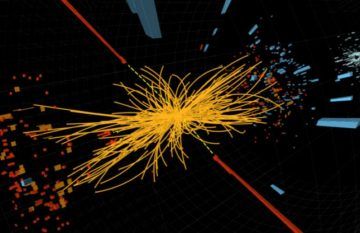Jennifer Ouellette in Ars Technica:
 The trickiest part of hunting for new elementary particles is sifting through the massive amounts of data to find telltale patterns, or “signatures,” for those particles—or, ideally, weird patterns that don’t fit any known particle, an indication of new physics beyond the so-called Standard Model. MIT physicists have developed an analytical method to essentially automate these kinds of searches. The method is based on how similar pairs of collision events are to one another and how hundreds of thousands of such events are related to each other.
The trickiest part of hunting for new elementary particles is sifting through the massive amounts of data to find telltale patterns, or “signatures,” for those particles—or, ideally, weird patterns that don’t fit any known particle, an indication of new physics beyond the so-called Standard Model. MIT physicists have developed an analytical method to essentially automate these kinds of searches. The method is based on how similar pairs of collision events are to one another and how hundreds of thousands of such events are related to each other.
The result is an intricate geometric map, dubbed a “collision network,” that is akin to mapping complex social networks. The MIT team described its novel approach in a new paper in Physical Review Letters: “Maps of social networks are based on the degree of connectivity between people, and for example, how many neighbors you need before you get from one friend to another,” co-author Jesse Thaler said. “It’s the same idea here.”
The Large Hadron Collider (LHC) produces billions of proton/antiproton collisions per minute. Physicists identify exactly which particles are produced in high-energy collisions by the electronic signatures the particles leave behind, known as nuclear decay patterns. Quarks, for instance, only exist for fractions of a second before they decay into other secondary particles. Since each quark has many different ways of decaying, there are several possible signatures, and each must be carefully examined to determine which particles were present at the time of the collision.
More here.
